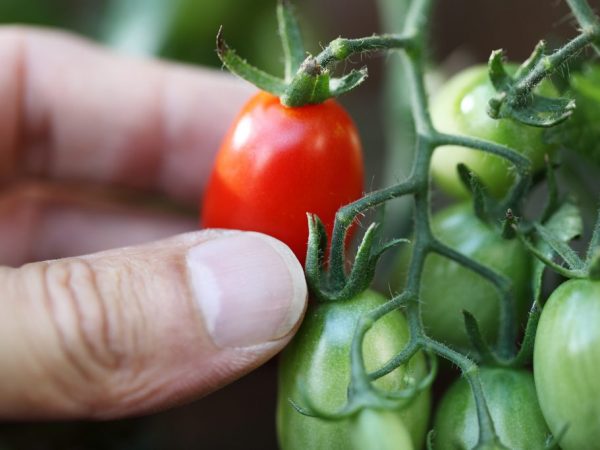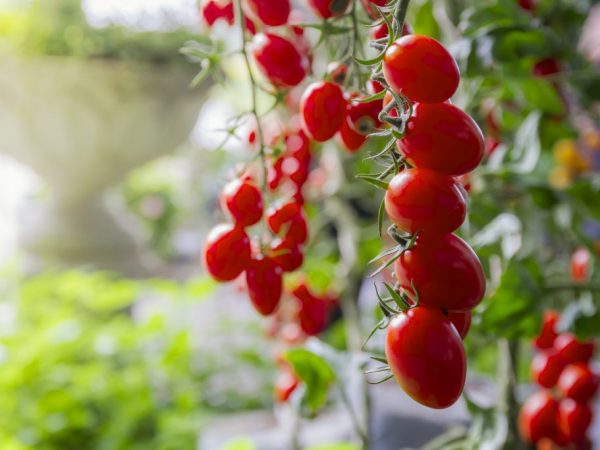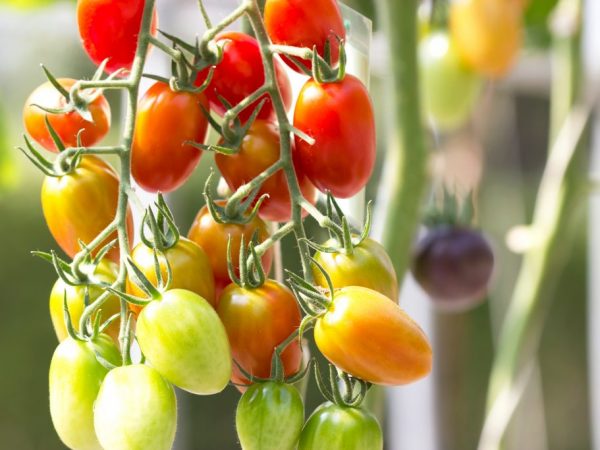Characteristics of the tomato variety Indoor Surprise
It's good when there is at least a small piece of land where you can plant vegetables. Not everyone is so lucky, but those who want to start gardening can build a garden on a windowsill or balcony. For this purpose, indoor cucumbers and tomatoes, which were created for such growing conditions, are best suited. Among the many varieties of domestic selection, you need to pay attention to the Indoor Surprise tomato. It meets all the requirements and desires of a true lover of indoor gardening and truck farming.

Characteristics of the tomato variety Indoor Surprise
Characteristics of the variety
This variety differs from other varieties of tomatoes in that it was created specifically for certain living conditions.
- Growing tomato Indoor Surprise is possible both in the greenhouse and on the windowsill.
- The cultivar behaves like a perennial plant.
- Refers to determinant species.
- It is used for summer decoration of flower beds and various compositions.
- Delicious fruits are suitable for consumption in any form.
- The plant is resistant to diseases and viruses of nightshade crops.
The indoor tomato does well in cramped pots and balcony drawers. At the same time, it does not lose its decorative effect and is capable of producing an excellent harvest.
Description of the plant
The determinant variety grows up to 50cm in height. The bush has a round shape and consists of several stems. With these tomatoes, you can leave 3 or 4 lower stepsons, and remove the rest. Stems not pubescent, have short internodes.
The leaves are in their shape, similar to potato leaves, the color is thick, green. There are not very many of them on the plant, but they are large and shiny. The veins on the leaves are clearly marked and embossed. Even if there is not enough lighting, neither the color of the leaves, nor their turgor is lost. Brushes begin to form almost at the very edge of the pot. They consist of: 6 or 10 flowers. Self-pollinating tomato quickly sets fruit. Their shape is plum-like, rounded, rather oblong.
Description of fruits
The fruits are distinguished by some positive features:
- bright red;
- dense and elastic skin;
- the pulp is not loose;
- seed chambers carry a small amount of seeds;
- they taste sweet and sour, tomato aroma;
- the weight of each of the fruits, about 50g;
- they are perfectly stored and transported without being damaged.
All these features make it possible to sell surplus products, both in local markets and by delivering beautiful products to other regions.
Fruit application

Tomato fruits will decorate any dish
Shiny tomato cream can be used as a decoration for dishes, in the form of original cuts in salads, and for processing. Even an ordinary salad will look festive if you put tomatoes and parsley or dill around the edges of the plate, alternating. Canned tomatoes look amazing. This is, of extraordinary beauty, a winter garden in banks.
Also, their sweetish taste, with an admixture of sourness, is well suited for the production of tomato paste and ketchup. When we add spices, we get a spicy and tasty adjika. Any of the blanks, not only beautiful in color, but also capable of giving appetite to other dishes.
Seed preparation and planting
The Indoor Surprise variety belongs to hybrids. Therefore, everyone who planted plants does not have the opportunity to collect their own seed. Seeds are purchased in specialized stores or sent by mail to firms that sell planting material.
For nurseries, transparent containers with lids or ordinary containers are used. Prepare the ground, which includes:
- pre-steamed garden soil;
- fine grained sand;
- ash mixture with peat;
- rotted manure.
The soil is considered suitable for sowing when it, slightly moistened, crumbles after being compressed. If the earth clumps into a ball, then you need to add more sand so that the tiny seeds can sprout freely. Sowing seeds for seedlings is carried out 60 days before planting in greenhouses or pots.
The seeds are poured with a solution of potassium permanganate, for several hours, for disinfection.
Then they are washed and dried a little so that they do not stick to the hands. Drainage and prepared soil are poured into the container. The seeds are leveled and spread evenly and densely, which are covered with a layer of earth in 1 cm. The surface of the soil is moistened with a spray gun and the containers are covered with transparent lids or polyethylene.
The temperature in nurseries must be stable. In the daytime around 25gr heat, and at night about 18gr. If the soil dries up, then it is sprayed without watering, so as not to erode the soil and not disturb the young shoots.
Seedling care
Growing tomatoes starts with growing healthy seedlings. After the emergence of shoots, you need to ensure that condensation does not collect on the lid or film. It can provoke gray rot. To prevent this from happening, it is necessary to ventilate the seedlings.
After the second pair of leaves has appeared, the seedlings dive into other containers. The distance between them is left necessary for free growth. In order for the seedlings to undergo a good transplant, they can be sprinkled with a weak solution of boric acid or a solution of citric acid (for 1 liter of water, several crystals).

Proper care will ensure you have a good harvest
Two months after sowing, you can prepare the seedlings for transplanting to a permanent place.
If these are flower beds or balcony boxes, then it must be hardened within 2 weeks. On the first day, open containers are exposed to the sun for half an hour. Every next day, sun exposure is doubled.
Landing in a permanent place
The prepared seedlings are carefully removed from the containers so as not to damage the fragile roots and stems. And if these are disposable cups, then you can simply transfer it into pots. Drainage is poured into balcony boxes or other utensils and soil is added. A hole is made with a peg, into which the seedling is placed and watered with water at room temperature.
Caring for potted tomatoes
Caring for the pots in which the plants are located is not difficult.
- It is necessary to water the plants so that the soil does not dry out.
- Low-growing tomatoes do not require a garter, but sometimes pegs can be placed to support the fruit bunches.
- Loosening of the soil must be constant.
- Fertilizing seedlings is often required because there is no access to nutrients to them, as is the case in the beds.
- It is necessary to engage in the prevention of diseases and viruses.
All these activities will make the cultivation of tomatoes successful not only in greenhouses or in flower beds, but also in small pots.
The containers are low in nutrients, so the description says that the planting and successful cultivation of the Indoor Surprise tomato will depend on its fertilization.At the bottom of the pots, you can put granules of long-soluble fertilizers or apply top dressing in the form of sticks. It is also watered with ammonium nitrate, which is diluted with water. For 5 liters of water, half a tablespoon of saltpeter is enough.
Disease prevention
In indoor conditions, it is practically impossible for a plant to get sick with late blight and other diseases. They are carried by the wind from other beds, and there is no wind in the room. But from excess moisture there is a risk of causing gray rot. To prevent this from happening, you need to use broad-spectrum fungicides. These can be: Fundazol, colloidal sulfur, copper sulfate and others. Plants need to be processed in places where pets will not be, and at the same time, observe personal hygiene.
Conclusion
Growing Tomatoes Indoor Surprise will be an interesting experience for tomato lovers. And the result will be simply amazing if you put a live tomato bush instead of a Christmas tree on the New Year holidays. Nothing beats the beauty of brightly colored tomatoes in winter, except for their exquisite taste. Sweet and aromatic fruits will decorate holiday tables. And dishes that are cooked every day will add a piquant taste of adzhika or ketchup cooked with your own hands.


